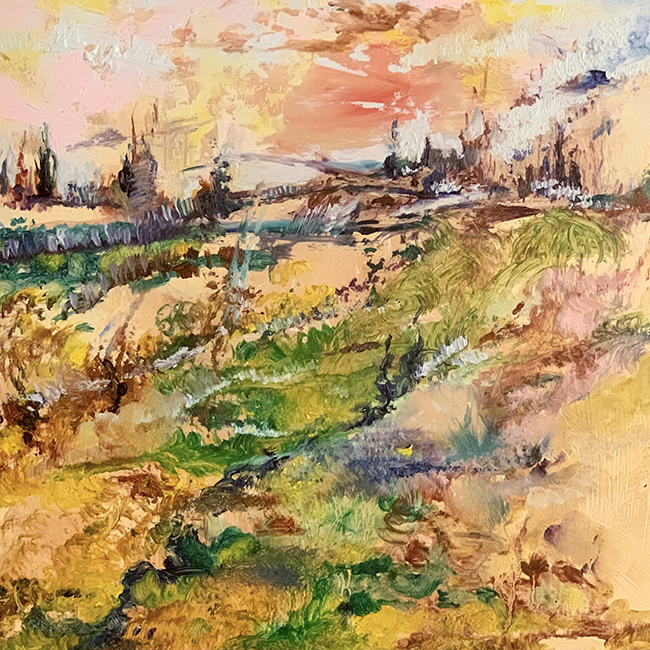Rita Basumallick is a New York–based artist whose work channels memory, movement, and the quiet power of nature. Born in India and now rooted in the U.S., she brings a cross-cultural sensitivity to the canvas. Her paintings often reflect personal experience layered with a larger emotional and environmental awareness. Trained at New York University and the New York Studio School, she combines formal education with an intuitive grasp of color and gesture. Rita also holds an MBA in Financial Markets from NYU Stern—an unexpected layer that adds a grounding presence to her otherwise fluid, lyrical compositions. Her work has appeared in different venues in New York City, including Chelsea galleries, the Brooklyn Artists Coalition, and the New York Art Expo. Internationally, she was part of the Dialogues for the Planetexhibition at the Museu Naval in Rio de Janeiro during the 2024–25 G20 cultural programming.

Rita’s style leans toward expressive abstraction, often anchored in landscape or organic forms. She gravitates toward color as both subject and vehicle—choosing bold, high-contrast palettes that seem to pulse and shimmer. But there’s restraint here too. Her work doesn’t rely on spectacle. It invites you to pause and take in the rhythm between brushstroke and negative space, between subject and mood.
Her painting The Farm is a good example. It’s a 12 x 12 inch oil on aluminum, and at first glance, it feels like a simple pastoral. But the scene isn’t about realism. It’s not a documentary image of rural life. Rita approaches the farm more like a feeling—something remembered, dreamed, or half-recognized.
The composition is built around natural forms but abstracted just enough to loosen the specifics. There are rolling hills, maybe a fence line or crop rows, but nothing sharply defined. The contours seem to flicker. She uses a Fauvist-inspired color scheme—pushing greens into citrus, golds into firelight, and skies into a coral hue that glows from within.
The brushwork is where the energy lives. It’s quick but not careless. Each stroke feels purposeful, building texture and movement. She uses the metal surface of the aluminum to her advantage—the paint sits slightly above it in places, creating a reflective shimmer that plays with the light in the room. This gives the painting a changing quality depending on where you stand.
There’s also something about the scale—just 12 inches square—that makes the piece feel personal, almost like holding a snapshot or a memory. It doesn’t try to dominate a wall. Instead, it draws you in. It’s a quiet gesture, but a complete one.
What’s consistent across her work is a sense of emotional heat. Even her cooler palettes don’t feel detached. There’s always a kind of push-pull between control and release. That’s probably where her training at the New York Studio School comes through—the school emphasizes observation but also insists on physical engagement with the material. Rita seems to have taken that to heart.
And though her work often centers on nature, it’s not about escaping the world. There’s an undercurrent of tension in her paintings, especially in how she handles contrast and edges. It’s not always peaceful. There’s friction. The beauty she paints is lived-in, complicated, and sometimes fragile.
This makes sense for someone who has moved between continents and cultures. Rita’s paintings don’t declare identity outright, but they’re shaped by a life that spans cities and languages. You can feel it in the way her work sits between abstraction and landscape, emotion and form. It’s neither fixed nor lost. It moves.
In exhibitions, her work tends to hold its own without flash. You don’t need to read a manifesto. You can feel what’s happening. That’s probably why her art has found space in both local and international shows. It communicates across borders—visually, emotionally, and even environmentally.
With The Farm and works like it, Rita Basumallick shows that painting can still be a place for reflection. Not nostalgia, exactly—but a kind of active remembering. A moment reclaimed through color, motion, and texture. A view of the natural world that feels intimate, even when imagined.

